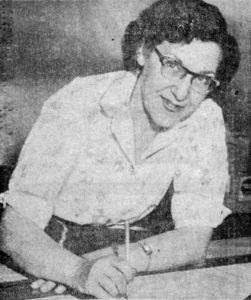Lottie Helwick
(1911–1992) worked in an era when a woman who performed essential work in
the realization of built structures never shared official credit for the projects she worked quietly behind the scenes to make possible. Helwick did “all the drawings” for the Cleveland Zoo’s iconic Pachyderm House while working for Hays & Ruth, including the critical subterranean engineering. But it was the role she played as an employee of Barnes Neiswander in the realization of Western Reserve University’s Nursing & Dental School complex that she regarded as “my finest contribution to architectural work.” Handed a sketch, “I went ahead and did the mechanical or electrical drawings all myself,” she told oral historian Stanley Garfinkel looking back from the age of 76. As word spread “that I could carry a gang of six or seven fellows, correct what they did and coordinate all the engineering and the architectural,” Helwick would be engaged as a valuable team member, in the course of her career, by 14 local design firms including Spahn & Barnes, Outcalt Guenther, and Hays & Ruth, who trusted her to “do the detail”—which ranged from creative decisions on things like doors and moldings that gave a building its distinctive touches…to the tricky coordination of design and the intricate engineering.
At Carnegie Tech, told she couldn’t study architecture “because I was a girl” and directed “upstairs” to Painting & Decorating, she stubbornly sat in the administrative office for a week till the school relented. When students’ design projects were hung in a long corridor for faculty judgment and she got higher grades than her classmates, the boys “wore sour faces,” she told Garfinkel, and cried “ ‘teacher’s pet!’ Well, I wasn’t. The damn teachers made me work harder than the rest of them.” Informed that girls couldn’t do math, she was soon grading papers for the math teacher. But after she’d completed two-and-half-years of studies in a year and a half, the Depression forced her to move back home.

Photo courtesy David Ellison

It was growing up in a 22-room old English house just up the hill from Western Reserve University designed by Franke Meade (with seven working fireplaces) that sparked her appreciation for and “the willingness to do” detailed architectural work. But Helwick, only the second woman ever to graduate from WRU in architecture, had already become a big-picture person. (Hired to do an addition for an avid collector of English wood engravings, she designed an entire room around the collections.) “When I got into a project, I wasn’t content to know just one part of it, I had to know what was happening in the whole ball of wax.” As an employee of Hays & Ruth she spent six months sitting “in a corner of the Cleveland Museum of Art,” for which Hays was doing an addition, “sorting out and putting all their drawings together from the original building on.”
Looking back, did she feel she was treated fairly and equally, she was asked. “No. Never. Salary-wise, never.” Did it ever make her mad? “Sure, but you didn’t dare show it. If you liked the work, you forgot about it. You went ahead and went to work.” Inducted into the American Institute of Architects (AIA) in 1942, Lottie Helwick would spend almost 10 years coordinating the activities of the Cleveland chapter, without pay.